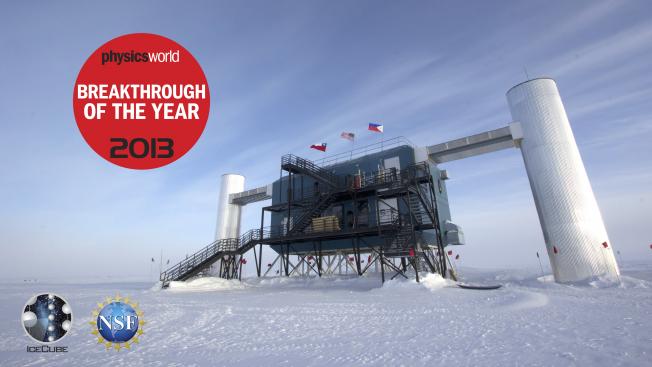Measuring the galactic plane and searching for galactic PeVatrons using the IceCube Multi-Flavor Astrophysical Neutrino sample
Proceedings of 39th International Cosmic Ray Conference — PoS(ICRC2025) Sissa Medialab (2025) 1193-1193
Authors:
Matthias Thiesmeyer, Tianlu Yuan, Leo Seen, Lu Lu, Albrecht Karle, Rasha Abbasi, Markus Ackermann, Jenni Adams, Sanjib Kumar Agarwalla, Juanan Aguilar, Markus Ahlers, Jean-Marco Alameddine, Shoukat Ali, Najia Moureen Binte Amin, Karen Andeen, Carlos Argüelles, Yosuke Ashida, Sofia Athanasiadou, Spencer Axani, Rishi Babu, Xinhua Bai, Joe Baines-Holmes, Aswathi Balagopal V, Steven W Barwick, Simeon Bash, Vedant Basu, Ryan Bay, James Beatty, Julia Becker Tjus, Philipp Behrens, Jakob Beise, Chiara Bellenghi, Bruno Benkel, Segev BenZvi, David Berley, Elisa Bernardini, Dave Besson, Erik Blaufuss, Lucas Bloom, Summer Blot, Ilya Bodo, Federico Bontempo, Julia Book Motzkin, Caterina Boscolo Meneguolo, Sebastian BOSER, Olga Botner, Jakob Bottcher, Jim Braun, Bennett Brinson, Zoe Brisson-Tsavoussis, Ryan T Burley, Delaney Butterfield, Michael Campana, Kiara Carloni, Jose Carpio, Sharmistha Chattopadhyay, Thien Nhan Chau, Zheyang Chen, Dmitry Chirkin, Seowon Choi, Brian Clark, Alan Coleman, Peter John Cusack Coleman, Gabriel Collin, Diego Alberto Coloma Borja, Amy Connolly, Janet Conrad, Rebecca Corley, Doug Cowen, Catherine DE CLERCQ, James DeLaunay, Diyaselis Delgado, Thomas Delmeulle, Shuyang Deng, Paolo Desiati, Krijn de Vries, Gwenhaël de Wasseige, Tyce DeYoung, Juan Carlos Diaz-Velez, Stephen DiKerby, Markus Dittmer, Alba Domi, Lincoln Draper, Lasse Dueser, Daniel Durnford, Kaustav Dutta, Michael DuVernois, Thomas Ehrhardt, Leonhard Eidenschink, Anna Eimer, Philipp Eller, Enrico Ellinger, Dominik Elsässer, Ralph Engel, Hannah Erpenbeck, Waleed Esmail, Steven Eulig, John Evans, Paul Evenson, Kwok Lung Fan, Ke Fang, Kareem Ramadan Farrag, Ali Fazely, Anatoli Fedynitch, Nora Feigl, Chad Finley, Leander Fischer, Derek B Fox, Anna Franckowiak, Satoshi Fukami, Philipp Furst, John Gallagher, Erik Ganster, Alfonso Garcia, Miles Garcia, Gopal Garg, Eliot Genton, Lisa Gerhardt, Ava Ghadimi, Christian Glaser, Thorsten Glüsenkamp, Javier Gonzalez, Sreetama Goswami, Alejandra Granados, Darren Grant, Shannon Gray, Sean Griffin, Spencer Griswold, Kathrine Morch Groth, David Joseph Guevel, Christoph Günther, Pascal Gutjahr, Chang Hyon Ha, Christian Haack, Allan Hallgren, Lasse Halve, Francis Halzen, Leon Hamacher, Martin Ha Minh, Michael Handt, Kael Hanson, John Hardin, Alexander Harnisch, Patrick Hatch, Andreas Haungs, Jonas Haussler, Klaus Helbing, Jonas Hellrung, Brandon Henke, Lukas Hennig, Felix Henningsen, Lars Philipp Heuermann, Rhia Hewett, Nils Heyer, Stephanie Hickford, Attila Hidvegi, Colton Hill, Gary Hill, Ramy Hmaid, Kara Hoffman, Dan Hooper, Sam Hori, Kotoyo Hoshina, Matheus Hostert, Wenjie Hou, Thomas Huber, Klas Hultqvist, Karolin Hymon, Aya Ishihara, Wataru Iwakiri, Marc Jacquart, Samyak Jain, Oliver Janik, Matti Jansson, Minjin Jeong, Miaochen Jin, Nicholas Kamp, Donghwa Kang, Woosik Kang, Xinyue Kang, Alexander Kappes, Leonora Kardum, Timo Karg, Martina Karl, Akanksha Katil, Matt Kauer, John Kelley, Manish Khanal, Arifa Khatee Zathul, Ali Kheirandish, Hani KimKu, Joanna Kiryluk, Carolin Klein, Spencer Klein, Yukiho Kobayashi, Alina Kochocki, Ramesh Koirala, Hermann Kolanoski, Tomas Kontrimas, Lutz Kopke, Claudio Kopper, Jason Koskinen, Paras Koundal, Marek Kowalski, Tetiana Kozynets, Niclas Krieger, Krishnamoorthi Jayakumar, Tanvi Krishnan, Karlijn Kruiswijk, Emmett Krupczak, Anil Kumar, Emma Kun, Naoko Kurahashi, Neha Navnitkumar Lad, Cristina Lagunas Gualda, Louise Lallement Arnaud, Mathieu Lamoureux, Michael J Larson, Frederik Hermann Lauber, Jeffrey Lazar, Kayla Leonard DeHolton, Agnieszka Leszczynska, Jiyuan Liao, Chace Lin, Yitong Liu, Maria Liubarska, Christy Love, Francesco Lucarelli, William Luszczak, Yang Lyu, Jim Madsen, Else Magnus, Kendall Mahn, Yuya Makino, Elena Manao, Sarah Mancina, Alicia Mand, Ioana Codrina Maris, Szabolcs Marka, Zsuzsa Marka, Lars Marten, Ivan Martinez-Soler, Reina H Maruyama, Jonathan Mauro, Finn Mayhew, Frank McNally, James Vincent Mead, Kevin Meagher, Sarah Mechbal, Andres Medina, Maximilian Meier, Yarno Merckx, Lukas Merten, Justin Mitchell, Logan Molchany, Teresa Montaruli, Roger Moore, Yasutsugu Morii, Anke Mosbrugger, Marjon Moulai, Despina Mousadi, Emile Moyaux, Tista Mukherjee, Richard Naab, Maxwell Nakos, Uwe Naumann, Jannis Necker, Ludwig Neste, Miriam Neumann, Hans Niederhausen, Mehr Un Nisa, Koji Noda, Andreas Noell, Alexander Novikov, Anna Pollmann, Vivian O'Dell, Alex Olivas, Rasmus Orsoe, Jesse Osborn, Erin O'Sullivan, Veronika Palusova, Hershal Pandya, Andrea Parenti, Nahee Park, Victoria Parrish, Ek Narayan Paudel, Larissa Paul, Carlos Pérez de los Heros, Teresa Pernice, Josh Peterson, Matthias Plum, Axel Ponten, Vaidehi Poojyam, Yuriy Popovych, Maria Prado Rodriguez, Brandon Pries, Rachel Procter-Murphy, Gerald Przybylski, Lilly Pyras, Christoph Raab, John Rack-Helleis, Navid Rad, Martin Langgård Ravn, Katherine Rawlins, Zoe Rechav, Abdul Rehman, Ian Reistroffer, Elisa Resconi, Simeon Reusch, Chang Dong Rho, Wolfgang Rhode, Leonardo Ricca, Benedikt Riedel, Adam Rifaie, Ella Roberts, Sally Robertson, Martin Rongen, Aske Rosted, Carsten Rott, Tim Ruhe, Li Ruohan, Dirk Ryckbosch, Julian Saffer, Daniel Salazar-Gallegos, Pranav Sampathkumar, Alexander Sandrock, Grace Sanger-Johnson, Marcos Santander, Subir Sarkar, Joelle Savelberg, Marco Scarnera, Patrick Schaile, Merlin Schaufel, Harald Schieler, Sebastian Schindler, Lea Schlickmann, Berit Schlüter, Felix Schlüter, Nick Schmeisser, Torsten Schmidt, Frank Schröder, Lisa Schumacher, Sonke Schwirn, Stephen Sclafani, David Seckel, Mohammad Ful Hossain Seikh, Suruj Seunarine, Per Arne Sevle Myhr, Riya Shah, Shefali Shefali, Shimizu N, Barbara Skrzypek, Robert Snihur, Jan Soedingrekso, Andreas Sogaard, Dennis Soldin, Philipp Soldin, Giacomo Sommani, Christian Spannfellner, Glenn Spiczak, Christian Spiering, Juliana Stachurska, Michael Stamatikos, Todor Stanev, Thorsten Stezelberger, Timo Sturwald, Thomas Stuttard, Greg Sullivan, Ignacio Taboada, Samvel Ter-Antonyan, Andrii Terliuk, Amar Thakuri, Will Thompson, Jessie Thwaites, Serap Tilav, Kirsten Tollefson, Simona Toscano, Delia Tosi, Alexandra Trettin, Anuj Kumar Upadhyay, Karriem Upshaw, Arun Vaidyanathan, Nora Valtonen-Mattila, Janeth Valverde, Justin Vandenbroucke, Thijs van Eeden, Nick van Eijndhoven, Lene van Rootselaar, Jakob van Santen, Francisco Javier Vara Carbonell, Fahim Varsi, Megha Venugopal, Matthias Vereecken, Sebastian Vergara Carrasco, Stef Verpoest, Doğa Veske, Aishwarya Vijai, Joshua Villarreal, Christian Walck, Andrew Wang, Elizabeth Warrick, Chris Weaver, Philip Weigel, Andreas Weindl, Jan Weldert, Alex Wen, Chris Wendt, Johannes Werthebach, Mark Weyrauch, Nathan Whitehorn, Christopher Wiebusch, Dawn Williams, Lucas Witthaus, Martin Wolf, Gerrit Wrede, Xianwu Xu, Juan Pablo Yanez, Yuhua Yao, Emre Burak Yildizci, Shigeru Yoshida, Robert Young, Felix Yu, Shiqi Yu, Angela Zegarelli, Shuo Zhang, Zelong Zhang, Pavel Zhelnin, Perri ZilbermanPerformance Study of the IceCube Upgrade Camera System
Proceedings of 39th International Cosmic Ray Conference — PoS(ICRC2025) Sissa Medialab (2025) 1069-1069
Authors:
Matti Jansson, Rasha Abbasi, Markus Ackermann, Jenni Adams, Sanjib Kumar Agarwalla, Juanan Aguilar, Markus Ahlers, Jean-Marco Alameddine, Shoukat Ali, Najia Moureen Binte Amin, Karen Andeen, Carlos Argüelles, Yosuke Ashida, Sofia Athanasiadou, Spencer Axani, Rishi Babu, Xinhua Bai, Joe Baines-Holmes, Aswathi Balagopal V, Steven W Barwick, Simeon Bash, Vedant Basu, Ryan Bay, James Beatty, Julia Becker Tjus, Philipp Behrens, Jakob Beise, Chiara Bellenghi, Bruno Benkel, Segev BenZvi, David Berley, Elisa Bernardini, Dave Besson, Erik Blaufuss, Lucas Bloom, Summer Blot, Ilya Bodo, Federico Bontempo, Julia Book Motzkin, Caterina Boscolo Meneguolo, Sebastian BOSER, Olga Botner, Jakob Bottcher, Jim Braun, Bennett Brinson, Zoe Brisson-Tsavoussis, Ryan T Burley, Delaney Butterfield, Michael Campana, Kiara Carloni, Jose Carpio, Sharmistha Chattopadhyay, Thien Nhan Chau, Zheyang Chen, Dmitry Chirkin, Seowon Choi, Brian Clark, Alan Coleman, Peter John Cusack Coleman, Gabriel Collin, Diego Alberto Coloma Borja, Amy Connolly, Janet Conrad, Rebecca Corley, Doug Cowen, Catherine DE CLERCQ, James DeLaunay, Diyaselis Delgado, Thomas Delmeulle, Shuyang Deng, Paolo Desiati, Krijn de Vries, Gwenhaël de Wasseige, Tyce DeYoung, Juan Carlos Diaz-Velez, Stephen DiKerby, Markus Dittmer, Alba Domi, Lincoln Draper, Lasse Dueser, Daniel Durnford, Kaustav Dutta, Michael DuVernois, Thomas Ehrhardt, Leonhard Eidenschink, Anna Eimer, Philipp Eller, Enrico Ellinger, Dominik Elsässer, Ralph Engel, Hannah Erpenbeck, Waleed Esmail, Steven Eulig, John Evans, Paul Evenson, Kwok Lung Fan, Ke Fang, Kareem Ramadan Farrag, Ali Fazely, Anatoli Fedynitch, Nora Feigl, Chad Finley, Leander Fischer, Derek B Fox, Anna Franckowiak, Satoshi Fukami, Philipp Furst, John Gallagher, Erik Ganster, Alfonso Garcia, Miles Garcia, Gopal Garg, Eliot Genton, Lisa Gerhardt, Ava Ghadimi, Christian Glaser, Thorsten Glüsenkamp, Javier Gonzalez, Sreetama Goswami, Alejandra Granados, Darren Grant, Shannon Gray, Sean Griffin, Spencer Griswold, Kathrine Morch Groth, David Joseph Guevel, Christoph Günther, Pascal Gutjahr, Chang Hyon Ha, Christian Haack, Allan Hallgren, Lasse Halve, Francis Halzen, Leon Hamacher, Martin Ha Minh, Michael Handt, Kael Hanson, John Hardin, Alexander Harnisch, Patrick Hatch, Andreas Haungs, Jonas Haussler, Klaus Helbing, Jonas Hellrung, Brandon Henke, Lukas Hennig, Felix Henningsen, Lars Philipp Heuermann, Rhia Hewett, Nils Heyer, Stephanie Hickford, Attila Hidvegi, Colton Hill, Gary Hill, Ramy Hmaid, Kara Hoffman, Dan Hooper, Sam Hori, Kotoyo Hoshina, Matheus Hostert, Wenjie Hou, Thomas Huber, Klas Hultqvist, Karolin Hymon, Aya Ishihara, Wataru Iwakiri, Marc Jacquart, Samyak Jain, Oliver Janik, Minjin Jeong, Miaochen Jin, Nicholas Kamp, Donghwa Kang, Woosik Kang, Xinyue Kang, Alexander Kappes, Leonora Kardum, Timo Karg, Martina Karl, Albrecht Karle, Akanksha Katil, Matt Kauer, John Kelley, Manish Khanal, Arifa Khatee Zathul, Ali Kheirandish, Hani KimKu, Joanna Kiryluk, Carolin Klein, Spencer Klein, Yukiho Kobayashi, Alina Kochocki, Ramesh Koirala, Hermann Kolanoski, Tomas Kontrimas, Lutz Kopke, Claudio Kopper, Jason Koskinen, Paras Koundal, Marek Kowalski, Tetiana Kozynets, Niclas Krieger, Krishnamoorthi Jayakumar, Tanvi Krishnan, Karlijn Kruiswijk, Emmett Krupczak, Anil Kumar, Emma Kun, Naoko Kurahashi, Neha Navnitkumar Lad, Cristina Lagunas Gualda, Louise Lallement Arnaud, Mathieu Lamoureux, Michael J Larson, Frederik Hermann Lauber, Jeffrey Lazar, Kayla Leonard DeHolton, Agnieszka Leszczynska, Jiyuan Liao, Chace Lin, Yitong Liu, Maria Liubarska, Christy Love, Lu Lu, Francesco Lucarelli, William Luszczak, Yang Lyu, Jim Madsen, Else Magnus, Kendall Mahn, Yuya Makino, Elena Manao, Sarah Mancina, Alicia Mand, Ioana Codrina Maris, Szabolcs Marka, Zsuzsa Marka, Lars Marten, Ivan Martinez-Soler, Reina H Maruyama, Jonathan Mauro, Finn Mayhew, Frank McNally, James Vincent Mead, Kevin Meagher, Sarah Mechbal, Andres Medina, Maximilian Meier, Yarno Merckx, Lukas Merten, Justin Mitchell, Logan Molchany, Teresa Montaruli, Roger Moore, Yasutsugu Morii, Anke Mosbrugger, Marjon Moulai, Despina Mousadi, Emile Moyaux, Tista Mukherjee, Richard Naab, Maxwell Nakos, Uwe Naumann, Jannis Necker, Ludwig Neste, Miriam Neumann, Hans Niederhausen, Mehr Un Nisa, Koji Noda, Andreas Noell, Alexander Novikov, Anna Pollmann, Vivian O'Dell, Alex Olivas, Rasmus Orsoe, Jesse Osborn, Erin O'Sullivan, Veronika Palusova, Hershal Pandya, Andrea Parenti, Nahee Park, Victoria Parrish, Ek Narayan Paudel, Larissa Paul, Carlos Pérez de los Heros, Teresa Pernice, Josh Peterson, Matthias Plum, Axel Ponten, Vaidehi Poojyam, Yuriy Popovych, Maria Prado Rodriguez, Brandon Pries, Rachel Procter-Murphy, Gerald Przybylski, Lilly Pyras, Christoph Raab, John Rack-Helleis, Navid Rad, Martin Langgård Ravn, Katherine Rawlins, Zoe Rechav, Abdul Rehman, Ian Reistroffer, Elisa Resconi, Simeon Reusch, Chang Dong Rho, Wolfgang Rhode, Leonardo Ricca, Benedikt Riedel, Adam Rifaie, Ella Roberts, Sally Robertson, Martin Rongen, Aske Rosted, Carsten Rott, Tim Ruhe, Li Ruohan, Dirk Ryckbosch, Julian Saffer, Daniel Salazar-Gallegos, Pranav Sampathkumar, Alexander Sandrock, Grace Sanger-Johnson, Marcos Santander, Subir Sarkar, Joelle Savelberg, Marco Scarnera, Patrick Schaile, Merlin Schaufel, Harald Schieler, Sebastian Schindler, Lea Schlickmann, Berit Schlüter, Felix Schlüter, Nick Schmeisser, Torsten Schmidt, Frank Schröder, Lisa Schumacher, Sonke Schwirn, Stephen Sclafani, David Seckel, Leo Seen, Mohammad Ful Hossain Seikh, Suruj Seunarine, Per Arne Sevle Myhr, Riya Shah, Shefali Shefali, Shimizu N, Barbara Skrzypek, Robert Snihur, Jan Soedingrekso, Andreas Sogaard, Dennis Soldin, Philipp Soldin, Giacomo Sommani, Christian Spannfellner, Glenn Spiczak, Christian Spiering, Juliana Stachurska, Michael Stamatikos, Todor Stanev, Thorsten Stezelberger, Timo Sturwald, Thomas Stuttard, Greg Sullivan, Ignacio Taboada, Samvel Ter-Antonyan, Andrii Terliuk, Amar Thakuri, Matthias Thiesmeyer, Will Thompson, Jessie Thwaites, Serap Tilav, Kirsten Tollefson, Simona Toscano, Delia Tosi, Alexandra Trettin, Anuj Kumar Upadhyay, Karriem Upshaw, Arun Vaidyanathan, Nora Valtonen-Mattila, Janeth Valverde, Justin Vandenbroucke, Thijs van Eeden, Nick van Eijndhoven, Lene van Rootselaar, Jakob van Santen, Francisco Javier Vara Carbonell, Fahim Varsi, Megha Venugopal, Matthias Vereecken, Sebastian Vergara Carrasco, Stef Verpoest, Doğa Veske, Aishwarya Vijai, Joshua Villarreal, Christian Walck, Andrew Wang, Elizabeth Warrick, Chris Weaver, Philip Weigel, Andreas Weindl, Jan Weldert, Alex Wen, Chris Wendt, Johannes Werthebach, Mark Weyrauch, Nathan Whitehorn, Christopher Wiebusch, Dawn Williams, Lucas Witthaus, Martin Wolf, Gerrit Wrede, Xianwu Xu, Juan Pablo Yanez, Yuhua Yao, Emre Burak Yildizci, Shigeru Yoshida, Robert Young, Felix Yu, Shiqi Yu, Tianlu Yuan, Angela Zegarelli, Shuo Zhang, Zelong Zhang, Pavel Zhelnin, Perri ZilbermanResults from IceCube Searches for High-Energy Neutrinos Coincident with Gravitational-Wave Alerts in LVK O4
Proceedings of 39th International Cosmic Ray Conference — PoS(ICRC2025) Sissa Medialab (2025) 1113-1113
Authors:
Zsuzsanna Marka, Jessie Thwaites, Justin Vandenbroucke, Doğa Veske, Rasha Abbasi, Markus Ackermann, Jenni Adams, Sanjib Kumar Agarwalla, Juanan Aguilar, Markus Ahlers, Jean-Marco Alameddine, Shoukat Ali, Najia Moureen Binte Amin, Karen Andeen, Carlos Argüelles, Yosuke Ashida, Sofia Athanasiadou, Spencer Axani, Rishi Babu, Xinhua Bai, Joe Baines-Holmes, Aswathi Balagopal V, Steven W Barwick, Simeon Bash, Vedant Basu, Ryan Bay, James Beatty, Julia Becker Tjus, Philipp Behrens, Jakob Beise, Chiara Bellenghi, Bruno Benkel, Segev BenZvi, David Berley, Elisa Bernardini, Dave Besson, Erik Blaufuss, Lucas Bloom, Summer Blot, Ilya Bodo, Federico Bontempo, Julia Book Motzkin, Caterina Boscolo Meneguolo, Sebastian BOSER, Olga Botner, Jakob Bottcher, Jim Braun, Bennett Brinson, Zoe Brisson-Tsavoussis, Ryan T Burley, Delaney Butterfield, Michael Campana, Kiara Carloni, Jose Carpio, Sharmistha Chattopadhyay, Thien Nhan Chau, Zheyang Chen, Dmitry Chirkin, Seowon Choi, Brian Clark, Alan Coleman, Peter John Cusack Coleman, Gabriel Collin, Diego Alberto Coloma Borja, Amy Connolly, Janet Conrad, Rebecca Corley, Doug Cowen, Catherine DE CLERCQ, James DeLaunay, Diyaselis Delgado, Thomas Delmeulle, Shuyang Deng, Paolo Desiati, Krijn de Vries, Gwenhaël de Wasseige, Tyce DeYoung, Juan Carlos Diaz-Velez, Stephen DiKerby, Markus Dittmer, Alba Domi, Lincoln Draper, Lasse Dueser, Daniel Durnford, Kaustav Dutta, Michael DuVernois, Thomas Ehrhardt, Leonhard Eidenschink, Anna Eimer, Philipp Eller, Enrico Ellinger, Dominik Elsässer, Ralph Engel, Hannah Erpenbeck, Waleed Esmail, Steven Eulig, John Evans, Paul Evenson, Kwok Lung Fan, Ke Fang, Kareem Ramadan Farrag, Ali Fazely, Anatoli Fedynitch, Nora Feigl, Chad Finley, Leander Fischer, Derek B Fox, Anna Franckowiak, Satoshi Fukami, Philipp Furst, John Gallagher, Erik Ganster, Alfonso Garcia, Miles Garcia, Gopal Garg, Eliot Genton, Lisa Gerhardt, Ava Ghadimi, Christian Glaser, Thorsten Glüsenkamp, Javier Gonzalez, Sreetama Goswami, Alejandra Granados, Darren Grant, Shannon Gray, Sean Griffin, Spencer Griswold, Kathrine Morch Groth, David Joseph Guevel, Christoph Günther, Pascal Gutjahr, Chang Hyon Ha, Christian Haack, Allan Hallgren, Lasse Halve, Francis Halzen, Leon Hamacher, Martin Ha Minh, Michael Handt, Kael Hanson, John Hardin, Alexander Harnisch, Patrick Hatch, Andreas Haungs, Jonas Haussler, Klaus Helbing, Jonas Hellrung, Brandon Henke, Lukas Hennig, Felix Henningsen, Lars Philipp Heuermann, Rhia Hewett, Nils Heyer, Stephanie Hickford, Attila Hidvegi, Colton Hill, Gary Hill, Ramy Hmaid, Kara Hoffman, Dan Hooper, Sam Hori, Kotoyo Hoshina, Matheus Hostert, Wenjie Hou, Thomas Huber, Klas Hultqvist, Karolin Hymon, Aya Ishihara, Wataru Iwakiri, Marc Jacquart, Samyak Jain, Oliver Janik, Matti Jansson, Minjin Jeong, Miaochen Jin, Nicholas Kamp, Donghwa Kang, Woosik Kang, Xinyue Kang, Alexander Kappes, Leonora Kardum, Timo Karg, Martina Karl, Albrecht Karle, Akanksha Katil, Matt Kauer, John Kelley, Manish Khanal, Arifa Khatee Zathul, Ali Kheirandish, Hani KimKu, Joanna Kiryluk, Carolin Klein, Spencer Klein, Yukiho Kobayashi, Alina Kochocki, Ramesh Koirala, Hermann Kolanoski, Tomas Kontrimas, Lutz Kopke, Claudio Kopper, Jason Koskinen, Paras Koundal, Marek Kowalski, Tetiana Kozynets, Niclas Krieger, Krishnamoorthi Jayakumar, Tanvi Krishnan, Karlijn Kruiswijk, Emmett Krupczak, Anil Kumar, Emma Kun, Naoko Kurahashi, Neha Navnitkumar Lad, Cristina Lagunas Gualda, Louise Lallement Arnaud, Mathieu Lamoureux, Michael J Larson, Frederik Hermann Lauber, Jeffrey Lazar, Kayla Leonard DeHolton, Agnieszka Leszczynska, Jiyuan Liao, Chace Lin, Yitong Liu, Maria Liubarska, Christy Love, Lu Lu, Francesco Lucarelli, William Luszczak, Yang Lyu, Jim Madsen, Else Magnus, Kendall Mahn, Yuya Makino, Elena Manao, Sarah Mancina, Alicia Mand, Ioana Codrina Maris, Szabolcs Marka, Lars Marten, Ivan Martinez-Soler, Reina H Maruyama, Jonathan Mauro, Finn Mayhew, Frank McNally, James Vincent Mead, Kevin Meagher, Sarah Mechbal, Andres Medina, Maximilian Meier, Yarno Merckx, Lukas Merten, Justin Mitchell, Logan Molchany, Teresa Montaruli, Roger Moore, Yasutsugu Morii, Anke Mosbrugger, Marjon Moulai, Despina Mousadi, Emile Moyaux, Tista Mukherjee, Richard Naab, Maxwell Nakos, Uwe Naumann, Jannis Necker, Ludwig Neste, Miriam Neumann, Hans Niederhausen, Mehr Un Nisa, Koji Noda, Andreas Noell, Kimberly Norrell, Alexander Novikov, Anna Pollmann, Vivian O'Dell, Alex Olivas, Rasmus Orsoe, Jesse Osborn, Erin O'Sullivan, Veronika Palusova, Hershal Pandya, Andrea Parenti, Nahee Park, Victoria Parrish, Ek Narayan Paudel, Larissa Paul, Carlos Pérez de los Heros, Teresa Pernice, Josh Peterson, Matthias Plum, Axel Ponten, Vaidehi Poojyam, Yuriy Popovych, Maria Prado Rodriguez, Brandon Pries, Rachel Procter-Murphy, Gerald Przybylski, Lilly Pyras, Christoph Raab, John Rack-Helleis, Navid Rad, Martin Langgård Ravn, Katherine Rawlins, Zoe Rechav, Abdul Rehman, Ian Reistroffer, Elisa Resconi, Simeon Reusch, Chang Dong Rho, Wolfgang Rhode, Leonardo Ricca, Benedikt Riedel, Adam Rifaie, Ella Roberts, Sally Robertson, MJ Romfoe, Martin Rongen, Aske Rosted, Carsten Rott, Tim Ruhe, Li Ruohan, Dirk Ryckbosch, Julian Saffer, Daniel Salazar-Gallegos, Pranav Sampathkumar, Alexander Sandrock, Grace Sanger-Johnson, Marcos Santander, Subir Sarkar, Joelle Savelberg, Marco Scarnera, Patrick Schaile, Merlin Schaufel, Harald Schieler, Sebastian Schindler, Lea Schlickmann, Berit Schlüter, Felix Schlüter, Nick Schmeisser, Torsten Schmidt, Frank Schröder, Lisa Schumacher, Sonke Schwirn, Stephen Sclafani, David Seckel, Leo Seen, Mohammad Ful Hossain Seikh, Suruj Seunarine, Per Arne Sevle Myhr, Riya Shah, Shefali Shefali, Shimizu N, Barbara Skrzypek, Robert Snihur, Jan Soedingrekso, Andreas Sogaard, Dennis Soldin, Philipp Soldin, Giacomo Sommani, Christian Spannfellner, Glenn Spiczak, Christian Spiering, Juliana Stachurska, Michael Stamatikos, Todor Stanev, Thorsten Stezelberger, Timo Sturwald, Thomas Stuttard, Greg Sullivan, Ignacio Taboada, Samvel Ter-Antonyan, Andrii Terliuk, Amar Thakuri, Matthias Thiesmeyer, Will Thompson, Serap Tilav, Kirsten Tollefson, Simona Toscano, Delia Tosi, Alexandra Trettin, Anuj Kumar Upadhyay, Karriem Upshaw, Arun Vaidyanathan, Nora Valtonen-Mattila, Janeth Valverde, Thijs van Eeden, Nick van Eijndhoven, Lene van Rootselaar, Jakob van Santen, Francisco Javier Vara Carbonell, Fahim Varsi, Megha Venugopal, Matthias Vereecken, Sebastian Vergara Carrasco, Stef Verpoest, Aishwarya Vijai, Joshua Villarreal, Christian Walck, Andrew Wang, Elizabeth Warrick, Chris Weaver, Philip Weigel, Andreas Weindl, Jan Weldert, Alex Wen, Chris Wendt, Johannes Werthebach, Mark Weyrauch, Nathan Whitehorn, Christopher Wiebusch, Dawn Williams, Lucas Witthaus, Martin Wolf, Gerrit Wrede, Xianwu Xu, Juan Pablo Yanez, Yuhua Yao, Emre Burak Yildizci, Shigeru Yoshida, Robert Young, Felix Yu, Shiqi Yu, Tianlu Yuan, Angela Zegarelli, Albert Zhang, Shuo Zhang, Zelong Zhang, Pavel Zhelnin, Perri ZilbermanSearch for heavy axions with the European X-Ray Free Electron Laser
Proceedings of 39th International Cosmic Ray Conference — PoS(ICRC2025) Sissa Medialab (2025) 524-524
Authors:
Subir Sarkar, Charles Arrowsmith, Carsten Baehtz, Konstantin Beyer, Robert Bingham, Sebastian Goede, Gianluca Gregori, Jack Halliday, Charles Heaton, Oliver Humphries, Alejandro Laso Garcia, Giacomo Marocco, Motoaki Nakatsutsumi, Richard Plackett, Thomas Preston, Ian Shipsey, Pontus Svensson, Georgios Vacalis, Justin Wark, Daniel Wood, Ulf ZastrauSpectrum of PeV Cosmic-Ray Protons and Helium Nuclei with IceCube
Proceedings of 39th International Cosmic Ray Conference — PoS(ICRC2025) Sissa Medialab (2025) 376-376



